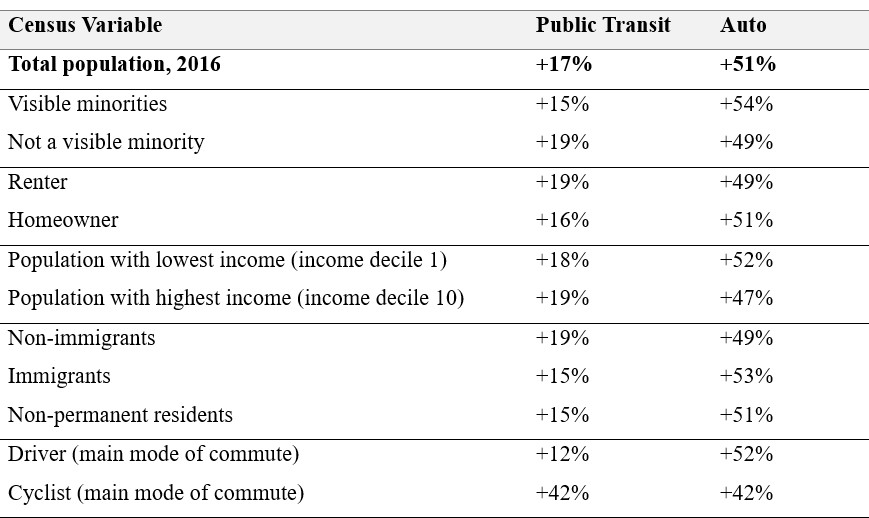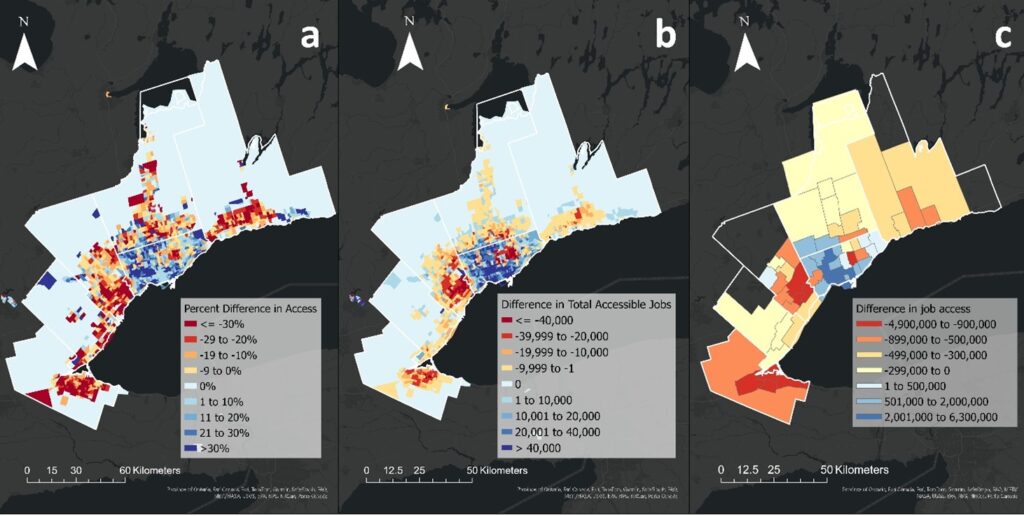Transportation Policy Levers
Research study:
Near-term transportation policy levers: Evaluating
their effects on air quality, equity, and accessibility
in the Greater Toronto and Hamilton Area (GTHA)
Objectives
- Understand the GHG emissions, air pollution exposure, and job accessibility impacts of near-term possible changes in the transport system, specifically before construction of new large transit infrastructure – which takes decades to deliver – can be completed.
- Examine the spatial distribution of changes in GHG emissions, air quality exposure, and accessibility of these near-term policy levers.
Methodology
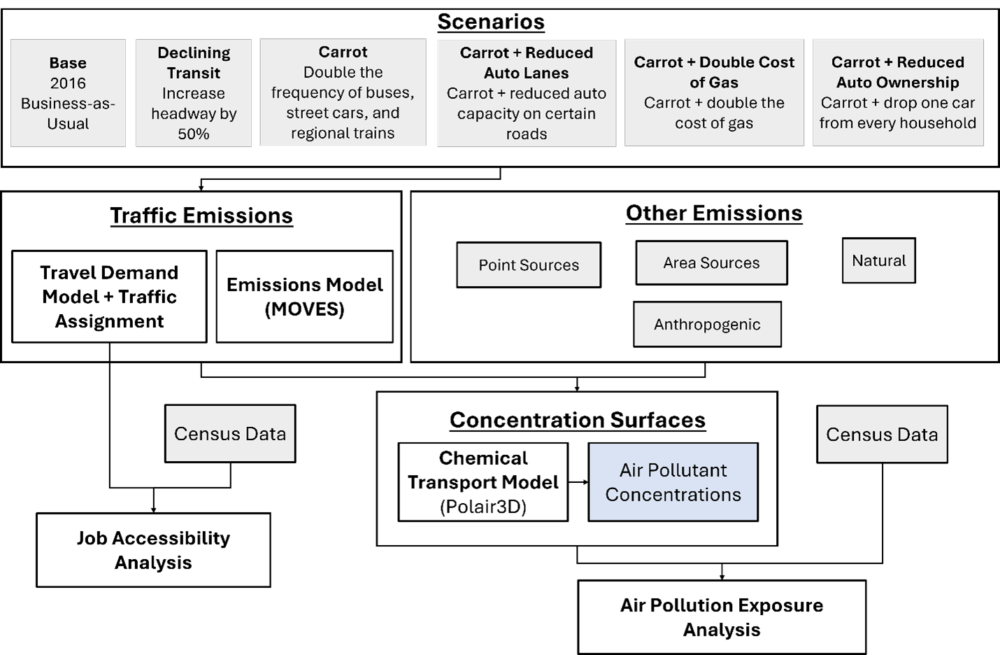
A modelling framework to estimate the air quality and accessibility implications of short-term policy levers.
- Designed five policy scenarios in which we varied the frequency of public transit, disincentivized automobile use, and reduced car ownership
- On-road vehicle emissions were estimated based on vehicle movement information – generated by the GTAModel V4.1, a widely used travel demand model – and emissions factors from the EPA MOVES model.
- A chemical transport model (CTM) was applied to generate air pollutant concentrations in the GTHA
- We compared changes in air quality (specifically, NO2 exposure) and job accessibility for six demographic groups: Visible Minority, Renter, Lowest Income Decile (persons who fall in the lowest 10% of the total income distribution), Non-immigrants, Driver (main commute mode), and Cyclist (main commute mode).
Limitations: To estimate travel behaviour under each policy scenario, we use a travel demand model which simulates activities and travel for a single day. The model enables us to understand individual changes in behaviour in response to immediate changes to the transportation network, but it does not account for long-term behavioural change (for example, whether an individual decides to purchase a vehicle or where they may choose to live). The model does not account for induced demand (for example, if an individual decides to take a new trip because of increased convenience) or suppressed demand (for example, an individual deciding to work from home due to traffic). This may lead to an underestimation of policy impacts on air quality.
Key findings
1. Daily total emissions of GHG, NOx, exhaust PM2.5, and non-exhaust PM2.5 for each scenario. The scenarios that trigger mode shift from private vehicles to public transit, such as the ‘Carrot + Doubled Cost of Gas’ and ‘Carrot + Reduced Auto Ownership’, lead to substantial reductions in GHG, NOx, and non-exhaust PM2.5 emissions. ‘Carrot’ refers to increased public transit capacity, in which we double the frequency of public transit buses, streetcars, and regional commuter trains.
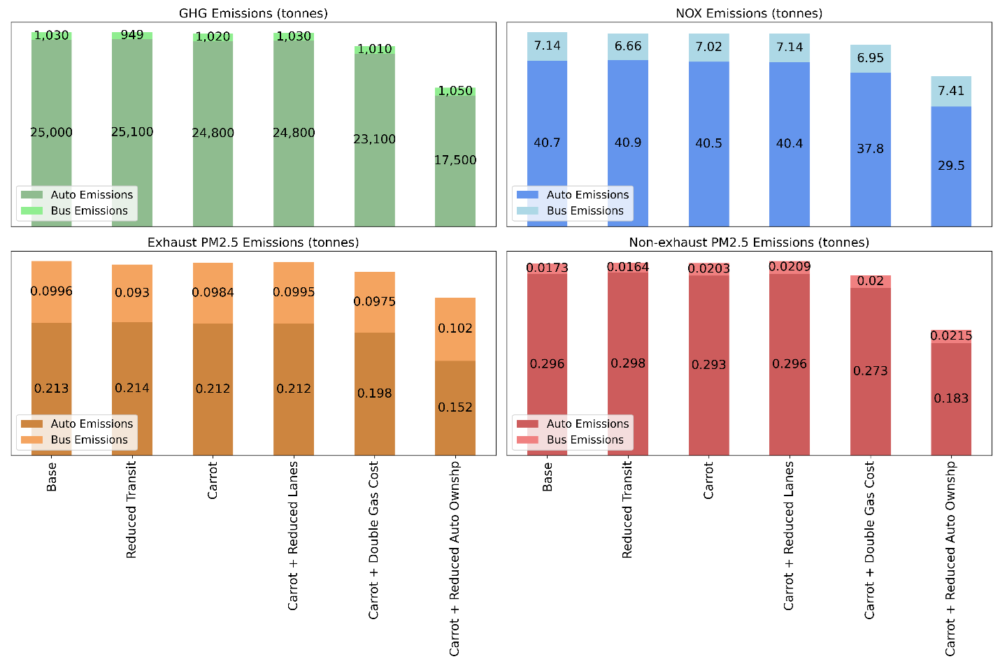
2. For the reduced transit scenario, we observe small increases in in GHG (+0.2%) and non-exhaust PM2.5 (+0.4%) emissions, whereas we observe a small reduction in NOx (-0.7%) and exhaust PM2.5 emissions (-1.8%). We observe emissions reductions across all other scenarios. Substantial reductions are observed under two scenarios: the scenario that heavily disincentivizes auto ownership by doubling the cost of gas (-5.6% exhaust PM2.5 emissions to -7.1% GHG emissions) and the scenario with reduced auto ownership (-18.7 exhaust PM2.5 emissions to -34.6% non-exhaust PM2.5 emissions).

3. Maps of (a) base case concentrations of NO2 (ppb), (b) the reduction in NO2 concentrations for the ‘Carrot + Reduced Auto Ownership’ scenario, compared against the base case, and (c) the percent reduction in NO2 concentrations for the ‘Carrot + Reduced Auto Ownership’ scenario, compared against the base case. ‘Carrot’ refers to increased public transit capacity, in which we double the frequency of public transit buses, streetcars, and regional commuter trains.
Reducing auto ownership is not just beneficial for those who live in downtown Toronto and Mississauga; we also observe up to a 7% reduction in NO2 concentrations in suburban regions. NO2 is an air pollutant linked to short- and long-term health effects, such as respiratory and cardiovascular diseases. Reducing exposure leads to improved health outcomes, particularly for children and elderly populations.

4. Policies that increase public transit capacity and reduced auto ownership reduce NO2 exposure for all neighbourhoods. The highest reductions occur with the neighbourhoods that have high proportions of renters, low-income households, and immigrant households (includes permanent residents and temporary residents). Similarly, the neighbourhoods with the highest quintile of cycling (as a commute mode) benefit the most from such a policy.
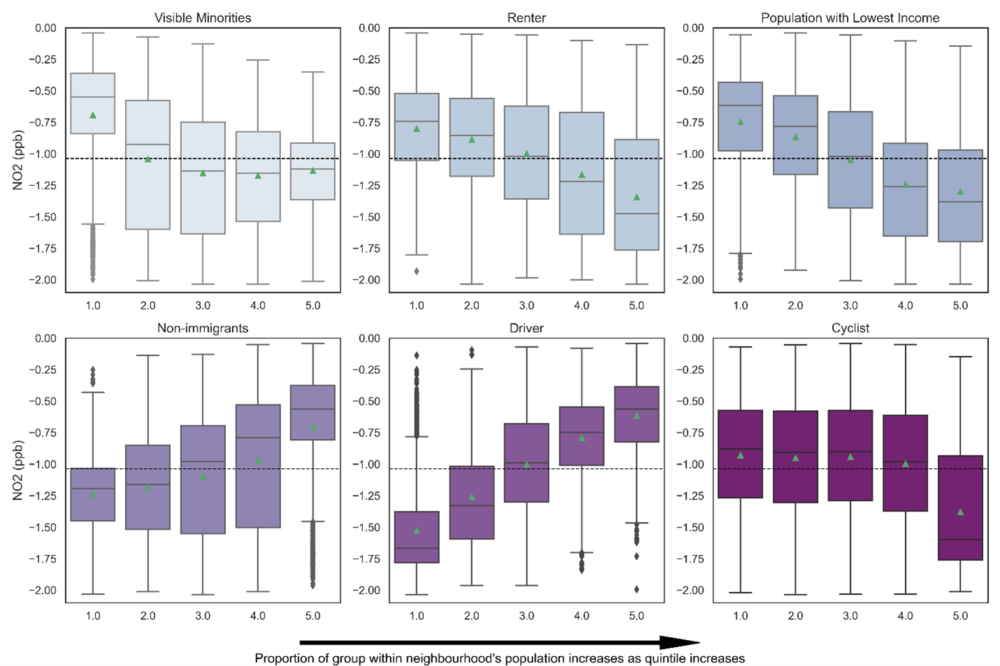
5. For both auto drivers and public transit users, we see net regional gains in job accessibility, across all demographic groups examined.
However, examining changes in job accessibility by public transit at a fine spatial resolution, we see that not every neighbourhood benefits from the ‘Carrot + Reduced Auto Ownership’ policy. Communities in the metro core tend to see dramatic gains in job accessibility by public transit, while suburban and car-commuter communities may see losses in job accessibility by public transit. This is due to the mismatch between public transit connectivity and the number of users who switch to public transit. The increased public transit frequency is insufficient for meeting the demand generated by reduced auto ownership.
Table 2: Percent change in jobs accessible by transit and by auto (30-min threshold) across demographic groups
